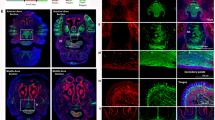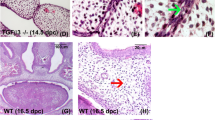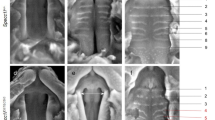Abstract
Mice lacking TGF–β3 exhibit an incompletely penetrant failure of the palatal shelves to fuse leading to cleft palate. The defect appears to result from impaired adhesion of the apposing medial edge epithelia of the palatal shelves and subsequent elimination of the mid–line epithelial seam. No craniofacial abnormalities were observed. This result demonstrates that TGF–β3 affects palatal shelf fusion Dy an intrinsic, primary mechanism rather than by effects secondary to craniofacial defects.
This is a preview of subscription content, access via your institution
Access options
Subscribe to this journal
Receive 12 print issues and online access
$209.00 per year
only $17.42 per issue
Buy this article
- Purchase on SpringerLink
- Instant access to full article PDF
Prices may be subject to local taxes which are calculated during checkout
Similar content being viewed by others
References
Roberts, A.B. & Sporn, M.B. The transforming growth factor betas. Peptide Growth Factors and Their Receptors — Handbook of Experimental Pathology (eds Sporn, M.B. & Roberts, A.B.) 419–472 (Springer-Veriag, New York, 1990).
Kingsley, D.M., TGF-beta superfamily: new members, new receptors, and new genetic tests of function in different organisms. Genes Dev. 8, 133–146 (1994).
Massague, J., Attisano, L. & Wrana, J. The complex interactions of TGF-β receptors. Trends Cell Biol. 4, 172–178 (1994).
Pelton, R.W., Saxena, B., Jones, M., Moses, H.L. & Gold, L.I. Immunohistochemical localization of TGF beta 1, TGF beta 2, and TGF beta 3 in the mouse embryo: expression patterns suggest multiple roles during embryonic development. J. CellBiol. 115, 1091–1105 (1991).
Schmid, P., Cox, D., Bilbe, G., Maier, R. & McMaster, G.K. Differential expression of TGF beta 1, beta 2 and beta 3 genes during mouse embryogenesis. Development 111, 117–130 (1991).
Milan, F.A., Denhez, F., Koncjaiah, P. & Akhurst, R.J. Embryonic gene expression patterns of TGF beta 1, beta 2 and beta 3 suggest different developmental functions in vivo. Development 111, 131–143 (1991).
Fitzpatrick, D.R., Denhez, F., Kondaiah, P. & Akhurst, R.J. Differential expression of TGF beta isoforms in murine palatogenesis. Development 109, 585–695 (1990).
Pelton, R.W., Hogan, B.L., Miller, D.A. & Moses, H.L. Differential expression of genes encoding TGFs beta 1, beta 2, and beta 3 during murine palate formation. Devl. Biol. 141, 456–460 (1990).
Brunei, C.L., Sharpe, P.M. & Ferguson, M.W.J. Inhibition of TGF-β3 (but not TGF-β1 or TGF-β2 activity prevents normal mouse embryonic palate fusion. Int. J. dev. Biol. 39, 345–355 (1995).
Chai, Y. et al. Specific transforming growth factor-beta subtypes regulate embryonic mouse Meckel's cartilage and tooth development. Devl. Biol. 162, 85–103 (1994).
Runyan, R.B., Potts, J.D. & Weeks, D.L. TGF-beta 3-mediated tissue interaction during embryonic heart development. Molec. Reprod. & Dev. 32, 152–159 (1992).
Robinson, S.D., Silberstein, G.B., Roberts, A.B., Flanders, K.C. & Daniel, C.W. Regulated expression and growth inhibitory effects of transforming growth factor-beta isoforms in mouse mammary gland development. Development 113, 867–878 (1991).
Shah, M., Foreman, D.M. & Ferguson, M.W.J. Neutralisation of TGFβ1 and TGFβ2 or exogenous addition of TGFβ3 to cutaneous rat wounds reduces scarring. J. Cell Sci. 108, 985–1002 (1995).
Pelton, R.W., Dickinson, M.E., Moses, H.L. & Hogan, B.L. In situ hybridization analysis of TGF beta 3 RNA expression during mouse development: comparative studies with TGF beta 1 and beta 2. Development 110, 609–620 (1990).
Ferguson, M.W.J. Palate development. Development 103, Suppl:41–60 (1988).
Dixon, M.J. & Ferguson, M.W.J. The effects of epidermal growth factor, transforming growth factors alpha and bete and platelet-derived growth factor on murine palatal shelves in organ culture. Arch. Oral Biol. 37, 395–410 (1992).
Gehris, A.L. & Greene, R.M. Regulation of murine embryonic epithelial cell differentiation by transforming growth factors beta. Differentiation 49, 167–173 (1992).
Shull, M.M. et al. Targeted disruption of the mouse transforming growth factOMbete 1 gene results in multifocal inflammatory disease. Nature 359, 693–699 (1992).
Kulkami, A.B. et al. Transforming growth factor beta 1 null mutation in mice causes excessive inflammatory response and early death. Proc. natn. Acad. Sci. U.S.A 90, 770–774 (1993).
Boivin, G.P. et al. Onset and progression of pathological lesions in transforming growth factornbete 1-deficient mice. Am. J. Pathol. 146, 276–288 (1995).
Kulkarni, A.B. et al. Transforming growth factor-beta 1 null mice. An animal model for inflammatory disorders. Am. J. Pathol. 146, 264–275 (1995).
Thomas, K.R. & Capecchi, M.R. Site-directed mutagenesis by gene targeting in mouse embryo-derived stem cells. Cell 51, 503–512 (1987).
Ferguson, M.W.J. Craniofacial malformations: towards a molecular understanding. Nature Genet. 6, 329–330 (1994).
Carette, M.J. & Ferguson, M.W.J. The fate of medial edge epithelial cells during palatal fusion in vitro: an analysis by Dil labelling and confocal microscopy. Development 114, 379–388 (1992).
Greene, R.M. & Pratt, R.M. Developmental aspects of secondary palate formation. J. Embryol. exp. Morph. 36, 225–245 (1976).
Morris-Wiman, J. & Brinkley, L. An extracellular matrix infrastructure provides support for murine secondary palatal shelf remodelling. Anat. Rec. 234, 575–586 (1992).
Ferguson, M.W.J. Palate development: mechanisms and malformations. Ir. J. Medical Sci. 156, 309–315 (1987).
D'Angelo, M., Chen, J.M., Ugen, K. & Greene, R.M. TGF beta 1 regulation of collagen metabolism by embryonic palate mesenchymal cells. J. exp. Zool. 270, 189–201 (1994).
Shuler, C.F., Halpern, D.E., Quo, Y. & Sank, A.C. Medial edge epithelium fate traced by cell lineage analysis during epithelial-mesenchymal transformation in vivo. Devl. Biol. 154, 318–330 (1992).
Griffith, C.M. & Hay, E.D. Epithelial-mesenchymal transformation during palatal fusion: carboxyfluorescein traces cells at light and electron microscopic levels. Development 116, 1087–1099 (1992).
Matzuk, M.M. et al. Functional analysis of activins during mammalian development. Nature 374, 354–356 (1995).
Matzuk, M.M., Kumar, T.R. & Bradley, A. Different phenotypes for mice deficient in either activins or activin receptor type II. Nature 374, 356–360 (1995).
Matzuk, M.M. et al. Multiple defects and perinatal death in mice deficient in follistatin. Nature 374, 360–363 (1995).
Gendron-Maguire, M., Mallo, M., Zhang, M. & Gridley, T. Hoxa-2 mutant mice exhibit homeotic transformation of skeletal elements derived from cranial neural crest. Cell 75, 1317–1331 (1993).
Rijli, F.M. et al. A homeotic transformation is generated in the rostral branchial region of the head by disruption of Hoxa-2, which acts as a selector gene. Cell 75, 1333–1349 (1993).
Satokata, I. & Maas, R. Msx1 deficient mice exhibit cleft palate and abnormalities of craniofacial and tooth development. Nature Genet. 6, 348–356 (1994).
Kurihara, Y. et al. Elevated blood pressure and craniofacial abnormalities in mice deficient in endothelin-1. Nature 368, 703–710 (1994).
Martin, J.F., Bradley, A. & Olson, E.N. The pairecWike homeo box gene MHox is required for early events of skeletogenesis in multiple lineages. Genes Dev 9, 1237–1249 (1995).
Lohnes, D. et al. Function of retinoic acid receptor gamma in the mouse. Cell 73, 643–658 (1993).
Brown, K.S. Genetics of clefting in the mouse: a critique. Prog. clin. biol. Res. 46, 77–69 (1980).
Letterio, J.J. et al. Maternal rescue of transforming growth factor-Beta 1 null mice. Science 264, 1936–1938 (1994).
Anscher, M.S. et al. Changes in plasma TGF beta levels during pulmonary radiotherapy as a predictor of the risk of developing radiation pneumonitis. Int. J. Radiat. Oncol., Biol., Phys. 30, 671–676 (1994).
Wahl, S.M. Transforming growth factor beta (TGF-beta) in inflammation: a cause and a cure. J. din. Immunol. 12, 61–74 (1992).
Chenevix-Trench, G., Jones, K., Green, A.C., Duffy, D.L. & Martin, N.G. Cleft lip with or without cleft palate: associations with transforming growth factor alpha and retinoic acid receptor loci. Am. J. hum. Genet. 51, 1377–1385 (1992).
Ardinger, H.H. et al. Association of genetic variation of the transforming growth factor-alpha gene with cleft lip and palate. Am. J. hum. Genet. 45, 348–353 (1989).
Shiang, R. et al. Association of transforming growth-factor alpha gene polymorphisms with nonsyndromic cleft palate only (CPO). Am. J. hum. Genet. 53, 836–843 (1993).
Hooper, M., Hardy, K., Handyside, A., Hunter, S. & Monk, M. HPRT-deficient (Lesch-Nyhan) mouse embryos derived from germline colonization by cultured cells. Nature 326, 292–295 (1987).
Laird, P.W. et al. Simplified mammalian DMA isolation procedure. Nud. Acids Res. 19, 4293 (1991).
Proetzel, G. Functional analysis of transforming growth factor-beta-3 using gene targeting. Doctoral thesis, University of Cincinnati College of Medicine. 1–156 (1994).
Chomczynski, P. & Sacchi, N. Single-step method of RNA isolation by acid guanidinium thiocyanate-phenol-chloroform extraction. Analyt. Biochem. 162, 156–159 (1987).
Keller, G., Kennedy, M., Papayannopoulou, T. & Wiles, M.V. Hematopoietic commitment during embryonic stem cell differentiation in culture. Molec. cell. Biol. 13, 473–486 (1993).
Wilson, J.G. Methods for administering agents and detecting malformation in experimental animals. In Teratology: principles and techniques (eds Wilson, J.G. & Warkany, J.) 262–277 (University of Chicago Press, Chicago, 1965).
Carette, M.J., Lane, E.B. & Ferguson, M.W. Differentiation of mouse embryonic palatal epithelium in culture: selective cytokeratin expression distinguishes between oral, medial edge and nasal epithelial cells. Differentiation 47, 149–161 (1991).
Author information
Authors and Affiliations
Rights and permissions
About this article
Cite this article
Proetzel, G., Pawlowski, S., Wiles, M. et al. Transforming growth factor–β3 is required for secondary palate fusion. Nat Genet 11, 409–414 (1995). https://doi.org/10.1038/ng1295-409
Received:
Accepted:
Issue Date:
DOI: https://doi.org/10.1038/ng1295-409
This article is cited by
-
The roles and regulatory mechanisms of TGF-β and BMP signaling in bone and cartilage development, homeostasis and disease
Cell Research (2024)
-
A Phase 1a Study to Evaluate Safety, Tolerability, Pharmacokinetics, and Pharmacodynamics of RO7303509, an Anti-TGFβ3 Antibody, in Healthy Volunteers
Rheumatology and Therapy (2024)
-
Using whole exome sequencing to identify susceptibility genes associated with nonsyndromic cleft lip with or without cleft palate
Molecular Genetics and Genomics (2023)
-
The Multifaceted Effects of Osteocytic TGFβ Signaling on the Skeletal and Extraskeletal Functions of Bone
Current Osteoporosis Reports (2023)
-
Transforming growth factor beta signaling functions during mammalian kidney development
Pediatric Nephrology (2021)



